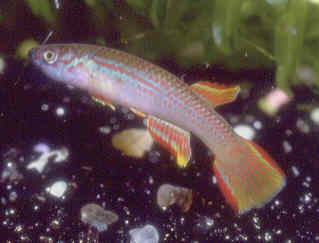Aphyosemion punctatum Radda & Pürzl 1977

A.punctatum circulating in the US around 1980. Photo: Courtesy of Lennie MacKowiak
Aphyosemion punctatum Radda & Pürzl 1977

A.punctatum circulating in the US around 1980. Photo: Courtesy of Lennie MacKowiak
| Meaning of Name |
Refers to the red spots punctuating the body. |
|||||||
| First Description |
Radda A.C. & Pürzl E. 1977 Cyprinodontiden Studien in Gabon II. Nordgabun. Aquaria 24 : p 29-31, figure 8. |
|||||||
| Size |
4.5 cm |
|||||||
| Meristics |
D = 11-12, A = 15-16, D/A = +8, ll = 29-30 (+2-3) (Radda & Pürzl 1977) |
|||||||
| Karyotype |
n = 12 , A = 24 (Scheel 1990) |
|||||||
| Sub-Genus |
Aphyosemion |
|||||||
| Group |
wildekampi |
|||||||
| Synonyms |
|
|||||||
Populations
|
Bolo Bai - Corrupted to Buong Bay.
Makokou - Collected by Rudolf Koubeck in 2000. A code K / OO exists for this collection.
|
|||||||
| Type Locality |
102 km from Mékambo in the direction of Makokou in a marshy stream. Collected by Radda & Pürzl 1975. |
|||||||
| Distribution |
Northern Gabon, from Makokou extending eastwards towards northern Congo. |
|||||||
| Habitat |
Rainforest brooks of the Ivindo River drainage
system. |
|||||||
| Distinguishing Characteristics | Few red spots on the body, mostly in the upper half. Caudal fin has outer margins top & bottom of red but often these do not reach the outer vertical edge as a thick continuous band, petering out in this area. | |||||||
| Colour/Pattern Variability | Medium | |||||||
| History |
Discovered by Gaspers et al in 1971 at the type locality, however these fish were not used in the original description. In 1974 Bochtler collected at this location then called G 10/74. These fish were used for the description. J.Lambert was informed of a collection of fish
under the name A.striatum ogoense
from Makokou on the Ivindu River. He observed differences in the pattern
& colouration between the 2 forms. Collected by Rudolf Kubeck in 2000 at Makokou. Oliver Lucanus collected them in 2004 from a small stream in the Lobeke National Park, southeast Cameroon. |
|||||||
| Breeding Notes |
Regarded as a difficult species to breed. Water incubation 12-14 days. Young are slow growers taking 7-8 months to reach sexual maturity. Tyrone Genade in BKA newsletter No.483, December
2005 reports breeding in water of 23-24°C. A mop & peat moss
with a few plants added. No filtration but a small airline with a trickle
of air. Water was changed at 25% weekly. Eggs were mainly found near
the tie in the mop at the surface & a tie near the base. |
|||||||
| Diameter of Egg | Around 1 mm. | |||||||
| Remarks |